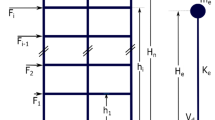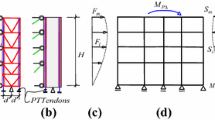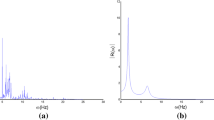Abstract
Unlike conventional seismic resisting systems, rocking core-moment frame (RCMF) combinations as low-damage assemblies are being developed to mitigate, or even eliminate structural damage and residual deformations following a severe earthquake. Despite extensive studies on the performance of specific rocking cores, dynamic characteristics and strength demands of a generic RCMF have not been addressed. By utilizing cantilever beam analogy, the current article proposes a modal analysis method to formulate RCMF demands. The proposed model and obtained analytical charts provide a manual method for rapid study and preliminary design of low- to mid-rise RCMFs with relatively uniform properties over the height. An extensive parametric study investigates the effects of rocking core base-fixity and frame-to-core stiffness on demand values. An independent computer analysis verifies the validity and accuracy of the proposed formulas. Findings show significant higher-mode effects in several RCMF combinations.












Similar content being viewed by others
References
ASCE (American Society of Civil Engineers) (2010) Minimum design loads for buildings and other structures. ASCE Standard ASCE/SEI 7-10. Reston, VA: American Society of Civil Engineers
Bozdogan KB (2009) An approximated method for static and dynamic analyses of symmetric wall-frame buildings. Struct Des Tall Build. https://doi.org/10.1002/tal.409
Chancellor NB, Akbas G, Sause R, Joo A (2012) Evaluation of performance-based design methodology for steel self-centering braced frame. In: Proceedings of 7th international conference on behavior of steel structures in seismic areas STESSA 2012, CRC Press, London
Chopra AK (2012) Dynamics of structures: theory and applications to earthquake engineering, 4th edn. Prentice Hall, Upper Saddle River
Eatherton M, Hajjar J (2010) Large-scale cyclic and hybrid simulation testing and development of a controlled-rocking steel building system with replaceable fuses. NSEL Rep. NSEL-025, University of Illinois at Urbana, Champaign, IL
Gray MG, Christopoulos C, Packer JA (2014) Cast steel yielding brace system for concentrically braced frames: Concept development and experimental validations. J Struct Eng 140(4):04013095
Grigorian M, Grigorian C (2015a) An introduction to the structural design of rocking wall-frames with a view to collapse prevention, self-alignment and repairability. Struct Des Tall Spec Build 25(2):93–111
Grigorian C, Grigorian M (2015b) Performance control and efficient design of rocking wall moment frames. J Struct Eng. https://doi.org/10.1061/(ASCE)ST.1943-541X.000141104015139
Grigorian M, Moghadam, AS, Mohammadi H (2017) On rocking core-moment frame design. In: Proceedings of 16th world conference on earthquake engineering, Santiago, Chile
Latham DA, Reay AM, Pampanin S (2013) Kilmore street medical centre: application of a post-tensioned steel rocking system. In: Proceedings of steel innovations conference 2013, Steel Construction New Zealand, Manuakau City, New Zealand
Ma X (2010) Seismic design and behavior of self-centering braced frame with controlled rocking and energy-dissipating fuses. Dissertation. Stanford Univ
Ma X, Krawinkler H, Deierlein GG (2011) Seismic design, simulation and shake table testing of self-centering braced frame with controlled rocking and energy dissipating fuses. Rep. No. 174, John A. Blume Earthquake Engineering Center, Stanford Univ
NRCC (National Research Council of Canada) (2010) National building code of Canada, Ottawa
OpenSees version 2.3.2 [Computer software]. Pacific Earthquake Engineering Research Center, Berkeley, CA
Priestley MJN, Calvi GM, Kowalsky MJ (2007) Displacement-based seismic design of structures. IUSS Press, Pavia
Qu Z, Wada A, Motoyui S, Sakata H, Kishiki S (2012) Pin-supported walls for enhancing the seismic performance of building structures. Earthq Eng Struct Dyn 41(14):2075–2091
Rafezy B, Zare A, Howson PW (2007) Coupled lateral-torsional frequencies of asymmetric, three dimensional frame structures. Int J Solids Struct 44:128–144
Rahgozar N, Moghadam SA, Aziminejad A (2016) Quantification of seismic performance factors for self centering controlled rocking special concentrically braced frame. Struct Des Tall Spec Build 25(14):700–723
Rahgozar N, Moghadam SA, Aziminejad A (2018) Continuum analysis approach for rocking core-moment frames. J Struct Eng. https://doi.org/10.1061/(ASCE)ST.1943-541X.0001986144(3):04018006
Roke D, Sause R, Ricles JM, Gonner N (2008) Design concepts for damage-free seismic resistant self-centering steel concentrically-braced frames. In: Proceedings of 14th world conference on earthquake engineering, International Association for Earthquake Engineering, Tokyo
Rutenberg A (2013) Seismic shear forces on RC walls: review and bibliography. Bull Earthq Eng 11:1726–1751
Stanford SB (1991) Tall building structures. Wiley, Chichester
Tremblay R, et al. (2008) Innovative viscously damped rocking braced frames. In: Proceedings of 14th world conference on earthquake engineering, International Association for Earthquake Engineering, Tokyo
Tse KT, Song J (2015) Modal analysis of a linked cantilever flexible building system. J Struct Eng 141:04015008
Wiebe L, Christopoulos C (2015) A cantilever beam analogy for quantifying higher mode effects in multistorey buildings. Earthq Eng Struct Dyn 44:1697–1716
Wiebe L, Christopoulos C, Tremblay R, Leclerc MA (2008) Mechanisms to limit higher mode effects in a controlled rocking steel frame 1: concept, modelling, and low-amplitude shake table testing. Earthq Eng Struct Dyn 42(7):1053–1068
Young D, Felgar RP (1949) Tables of characteristic functions representing normal modes of vibration of a beam, Publication 4913 Univ of Texas
Author information
Authors and Affiliations
Corresponding author
Rights and permissions
About this article
Cite this article
Rahgozar, N., Moghadam, A.S. & Aziminejad, A. Cantilever beam analogy for modal analysis of rocking core-moment frames. Bull Earthquake Eng 16, 4081–4106 (2018). https://doi.org/10.1007/s10518-018-0401-1
Received:
Accepted:
Published:
Issue Date:
DOI: https://doi.org/10.1007/s10518-018-0401-1




